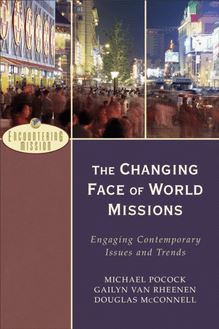Intercultural Discipleship (Encountering Mission) , livre ebook
224
pages
English
Ebooks
2017
Vous pourrez modifier la taille du texte de cet ouvrage
Obtenez un accès à la bibliothèque pour le consulter en ligne En savoir plus
Découvre YouScribe en t'inscrivant gratuitement
Découvre YouScribe en t'inscrivant gratuitement
224
pages
English
Ebooks
2017
Vous pourrez modifier la taille du texte de cet ouvrage
Obtenez un accès à la bibliothèque pour le consulter en ligne En savoir plus
Publié par
Date de parution
05 décembre 2017
Nombre de lectures
0
EAN13
9781493411481
Langue
English
Poids de l'ouvrage
5 Mo
Publié par
Date de parution
05 décembre 2017
Nombre de lectures
0
EAN13
9781493411481
Langue
English
Poids de l'ouvrage
5 Mo
Cover
Series Page
A. Scott Moreau, series editor
A LSO IN THE S ERIES :
Introducing World Missions: A Biblical, Historical, and Practical Survey
A. Scott Moreau, Gary R. Corwin, and Gary B. McGee
The Changing Face of World Missions: Engaging Contemporary Issues and Trends
Michael Pocock, Gailyn Van Rheenen, and Douglas McConnell
Encountering Missionary Life and Work: Preparing for Intercultural Ministry
Tom Steffen and Lois McKinney Douglas
Christianity Encountering World Religions: The Practice of Mission in the Twenty-first Century
Terry Muck and Frances S. Adeney
Encountering Theology of Mission: Biblical Foundations, Historical Developments, and Contemporary Issues
Craig Ott and Stephen J. Strauss with Timothy C. Tennent
Developing a Strategy for Missions: A Biblical, Historical, and Cultural Introduction
John Mark Terry and J. D. Payne
Effective Intercultural Communication: A Christian Perspective
A. Scott Moreau, Evvy Hay Campbell, and Susan Greener
Encountering the History of Missions: From the Early Church to Today
John Mark Terry and Robert L. Gallagher
Title Page
Copyright Page
© 2017 by W. Jay Moon
Published by Baker Academic
a division of Baker Publishing Group
P.O. Box 6287, Grand Rapids, MI 49516-6287
www.bakeracademic .com
Ebook edition created 2017
All rights reserved. No part of this publication may be reproduced, stored in a retrieval system, or transmitted in any form or by any means—for example, electronic, photocopy, recording—without the prior written permission of the publisher. The only exception is brief quotations in printed reviews.
Library of Congress Control Number: 2017023409
ISBN 978-1-4934-1148-1
Scripture quotations are from the Holy Bible, New International Version®. NIV®. Copyright © 1973, 1978, 1984, 2011 by Biblica, Inc.™ Used by permission of Zondervan. All rights reserved worldwide. www.zondervan.com
Endorsements
“Where was this book when I needed it as an upstart cross-cultural novice forty-five years ago? Jay Moon truly brings it all together in this remarkable volume chock-full of keen insights, case studies, and practical applications from fields as far ranging as cultural anthropology, mission research, orality, symbolism and ritual studies, and ethnodoxology. This book is where you should start if you are a mission thinker or practitioner wanting to deepen your understanding of and effectiveness in intercultural Christian discipling. I could have and would have made good use of it a long time ago!”
— James R. Krabill , senior mission advocate, Mennonite Mission Network; general editor of Worship and Mission for the Global Church: An Ethnodoxology Handbook
“The cry for better discipleship methods is heard around the globe but most methods take a fill-in-the-blank approach, focused on acquiring more information , not the deep penetrating formation of disciples of Jesus that promotes personal and community transformation. Now Jay Moon in Intercultural Discipleship has charted a comprehensive and creative way forward like no other book in the field. Missiologically informed, cross-culturally relevant, and biblically faithful, this book draws on genres such as proverbs, drama, music, dance, rituals and ceremonies, and oral arts, together with riveting case studies to open the right side of our brains for disciple-makers around the world. I believe Intercultural Discipleship will soon become a classic text in the discipleship literature.”
— Darrell Whiteman , publisher, American Society of Missiology
“Drawing on his extensive experience living cross-culturally, Jay Moon has produced a very readable and resourceful guide to making disciples. Enhanced by a global perspective, Intercultural Discipleship not only provides a valuable primer on understanding the relationship between faith and culture but also offers practical ways to utilize this knowledge for the sake of growing faithful and discerning disciples.”
— Bonnie Sue Lewis , professor of mission and world Christianity, University of Dubuque Theological Seminary
“What could discipleship look, feel, smell, and sound like in this era of global cultural complexity? Immensely helpful in its integration of theory and practical know-how, Intercultural Discipleship is a resourceful pathway for deep learning and transformative growth for all teachers and students of culture, change agents, and hermeneutical communities interested in creative discipleship approaches that foster radical inclusion and participation in mission.”
— Uday Mark Balasundaram , founder, Estuary Cultures and Order of Bezalel
“If this book gets the reading it deserves, we are at the dawning of a great new day for making disciples, and not just overseas. Skillfully drawing on several works that were ahead of their time (e.g., Symbol and Ceremony by A. H. Mathias Zahniser), Moon tells fascinating, instructive stories of those who practice what they preach. I had to keep putting the book down to add ideas to my to-do list.”
— Stan Nussbaum , developer, SYNC Discipleship Program
Dedication
This book is dedicated to my lovely wife and the four blessings that God has given us:
Jeremy, Emily, Joshua, and Bethany; as well our expanding family of Emily and Madison; and the little bundle of joy, Audrey
Contents
Cover i
Series Page ii
Title Page iii
Copyright Page iv
Endorsements v
Dedication vi
Acknowledgments viii
Preface xi
1. How Did We Get in This Spiritual Rut? 1
2. Issues That Get Us Stuck 24
3. What Is Intercultural Discipleship? 44
4. Symbols Speak When Words Can’t 68
5. Rituals Drive Meaning Deep into the Bone 90
6. Contextualization Process—Tailored Pants Fit Just Right 111
7. Stories Portray It, Not Just Say It 135
8. Proverbs Are Worth a Thousand Words 158
9. Music, Dance, and Drama—We Become What We Hum 182
10. Holistic Discipleship Connects Word and Deed 207
11. Discipleship for Postmoderns 230
Conclusion 263
Appendix A: Ceremony for the Installation of a Teacher 271
Appendix B: Activities for Teaching 274
Reference List 280
Index 293
Back Cover 301
Acknowledgments
Juum kan basi bu nyonowa zasimwa. (A fish always smells like its parents.)
—Builsa proverb
Notice Something “Fishy”?
Pastor Monday, seated with the other African pastors, arises from the wooden bench. With the smell of groundnut soup and goat meat still hanging in the air, we sit around finished plates, talking as only good friends can. I can’t think of a better way to wrap up my parents’ two-week visit to Ghana.
A smile flashes across Monday’s face as he focuses his eyes on my parents and quips, “Juum kan basi bu nyonowa zasimwa” (A fish always smells like its parents).
The pastors erupt in laughter, shortly followed by applause of approval. A high compliment, the proverb is near the English equivalent of “like father, like son.” Monday is thanking my parents for their role and influence to send me to Ghana.
My heart swells with pride and deep love as I look at my parents. I cannot express it any better. My parents supported and encouraged Pam and me at every turn, and I will never be able to fully express my gratitude for their continued support.
In the years since that day in Ghana, my parents have continued to be a great source of encouragement and inspiration. My mom has since passed away, but her influence is still felt every day.
God has also blessed me with an amazing woman to walk hand in hand on this faith journey. My wife, Pam, has lived out the pages of this book through her steady and consistent faithfulness to God. Her willingness to experience other cultures and take steps of faith is a testament to God’s goodness and faithfulness. I have been privileged to walk alongside her for thirty years. Our children—Jeremy, Emily, Josh, Bethany—and our newest family members, Emily Julia, Madison, and Audrey, have also taught me how to learn from another generation. They are a constant source of joy to Pam and me. I can’t think of a more fun group to share this journey of life with.
Along my journey, other key figures have shaped and molded this book. One of those friends is Darrell Whiteman, whose influence pervades this book. At times, I am not sure where his teaching leaves off and my own thoughts pick up. He has been a steady mentor and encourager since the day I first met him. His substantial comments and encouragement for this book provided helpful direction and guidance.
The idea for this book first came from Mathias Zahniser. Like a fish caught by a hook, I was reeled in by a course he taught, Cross-Cultural Discipling, at Asbury Theological Seminary. Matt opened my eyes to the role of symbols and ceremonies in the discipleship process. After I took the course as a doctoral student, Matt asked me to be a teaching assistant the following year. The third year, he asked me to help teach a portion of the course. The fourth year, Matt, exercising true discipleship, asked me to teach the entire course while he sat in the class as a student! Following each class period, he reviewed the entire class session with frank critique and encouragement.
Matt released this fish from his hands, and, humbled yet empowered, I have taught this course for the past ten years at both Sioux Falls Seminary and Asbury Theological Seminary. To trace the original smell of this book, read Matt’s groundbreaking book Symbols and Ceremonies (1997). My hope is that this book in your hands will influence you in the same way that it has me.
Students from this class took these ideas and developed them in ways that I could not have imagined. While only a small portion of these examples appear in this book, I have learned much from my students’ experiments. This experience has confirmed for me that alternate discipleship patterns are practical for many contexts.
I first observed the principles of intercultural discipleship through the actions of African church leaders with the Bible Church of Africa in Ghana. They demonstrated how ora








